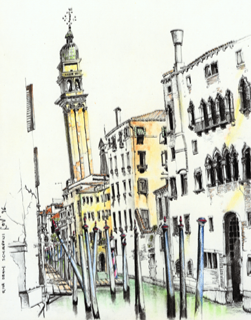|
Rome: The Eastern Empire, Constantinople
Constantinople: Hagia Sophia
Italy - Rome: Catacombs
Rome: Aqueducts
Rome: Old St. Peter's Basilica
Rome: St. Paul Outside The Walls
Ravenna: San Vitale
Ravenna: St. Apollinare in Classe
Venice: Overview
Venice: Basilica di San Marco and Environs
Venice:The Interior of San Marco
Venice Ambiance
|
VENICE We could attribute the unique beauty of Venice to the barbaric hordes already discussed. In some way, they were responsible for the Venice that we know, because people living on the mainland tried to escape the continual waves of those marauders about the 5th century. They advanced into the shallow waters of the lagoon here, creating a city on stilts, connecting a multitude of islands (there were 120) with 450 bridges, and were relatively safe. It is most difficult to attack in the water, because ships are vulnerable. The notion goes back to prehistoric times. In Lake Constance, for example, specifically the city of Konstanz, at the border of Germany and Switzerland, is evidence (now reconstructed) of just such an occurrence. People went into the water, built their homes on stilts, shared communal outdoor cooking spaces, surrounded themselves with a stockade, and endured. This happened more than 4,000 years ago, so the Venetians were not inventing anything; they just used common sense. A lot of politicians should develop this mental capability when dealing with our communities: survival based on common sense - something we can learn by digging into history.  A little sketch I did, and the tower is actually leaning.
The early Venetians built their houses leaning one against the other, forming solid rows, and creating courtyards (campos) in the process, between those rows of houses. The Republic of Venice developed, prospered, and expanded, particularly in the middle of the 15th century. Territories extended through what we call the Veneto (northern Italy westward past Verona), then part of Lombardy. Going eastward, the Venetians occupied Dalmatia, towards Trieste, which became Yugoslavia, and is today Croatia. Aegean Islands were occupied, and colonies, trade routes, and ports were controlled in Greece and Asia Minor.
Artists (painters and sculptors), and architects flourished, particularly in the Renaissance, and we'll explore more in the second semester of this course.
PIAZZA SAN MARCO
Approaching the Piazza San Marco, we first pass through narrow, rather dark passageways - at least in this filming - and so the light appears even more alluring as it beckons us at the end of that darkness. The Italian word "chiaroscuro, literally meaning light/dark, exemplifies this change from – well, in this case, from dark to light." I am always reminded of a boutique dress shop in Greenwich Village dubbed "Chiasorscuro," featuring only black and white clothes.
A bit of our “serial vision” as we approach from slightly west of north, with San Marco obviously ahead. It really is this way with so many European streets, especially in Italy, with its multitude of piazzas - the chiaroscuro effect in the town plan. But this is too easy an entrance, and we shall go around to the west. Expectation is always best when savored, like sniffing a good wine or brandy. Again a story comes to mind: Louis Kahn describing how on his first visit to Pisa he circled about, almost not daring to enter the complex, buying what he described as "an ill-fitting English jacket" before entering the confines of the Cathedral grounds.
Through an arch of the arcade, which surrounds the Piazza San Marco on three sides, a light hangs suspended - we will see more of those lights as we enter what has been called "the grandest drawing room in the world." A small note: the term "drawing room" refers to a reception or living room within a home, but it is just as applicable to speak in artistic terms.
Passing between columns, the piazza - ringed by shops -
appears in a glimpse now and again, until we see the campanile (bell tower) and in a moment the church itself - San Marco.
Look around - here, for example, you can stroll, sit, eat, drink, and listen to music - all of, or perhaps more than, the comforts of home. The piazza is the center of city life in Venice, and in any Italian city. Here the marble-paved public atrium is dedicated to the sea-city's patron saint, Mark.
If one can single out a particular item of hierarchy, it might be the campanile, but only because of its height, and the way in which its verticality acts as counterpoint to the prevailing horizontality so current in the earlier Italian designs. Here we view it from the lagoon to the south of the Piazza. That campanile was rebuilt after a collapse in 1902. It is apparently faithful to an early 16th century design. It serves as both a bell tower as well as a watchtower, and is a symbol of power. The height is approximately 99 meters (325 feet) above the ground. © Architecture Past Present & Future - Edward D. Levinson, 2009 |